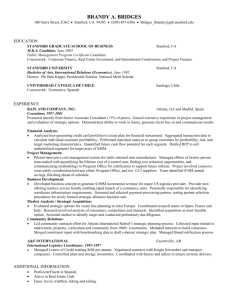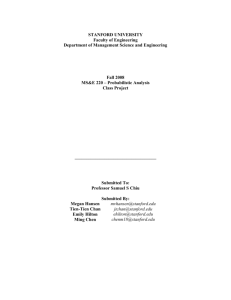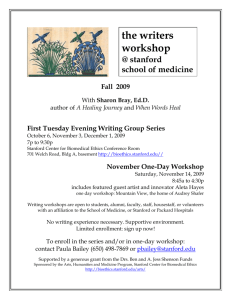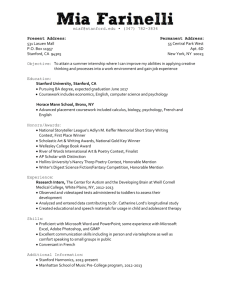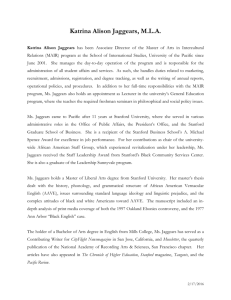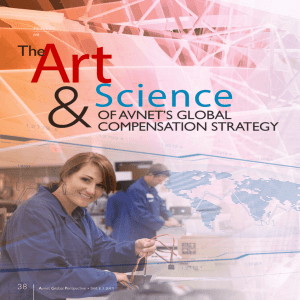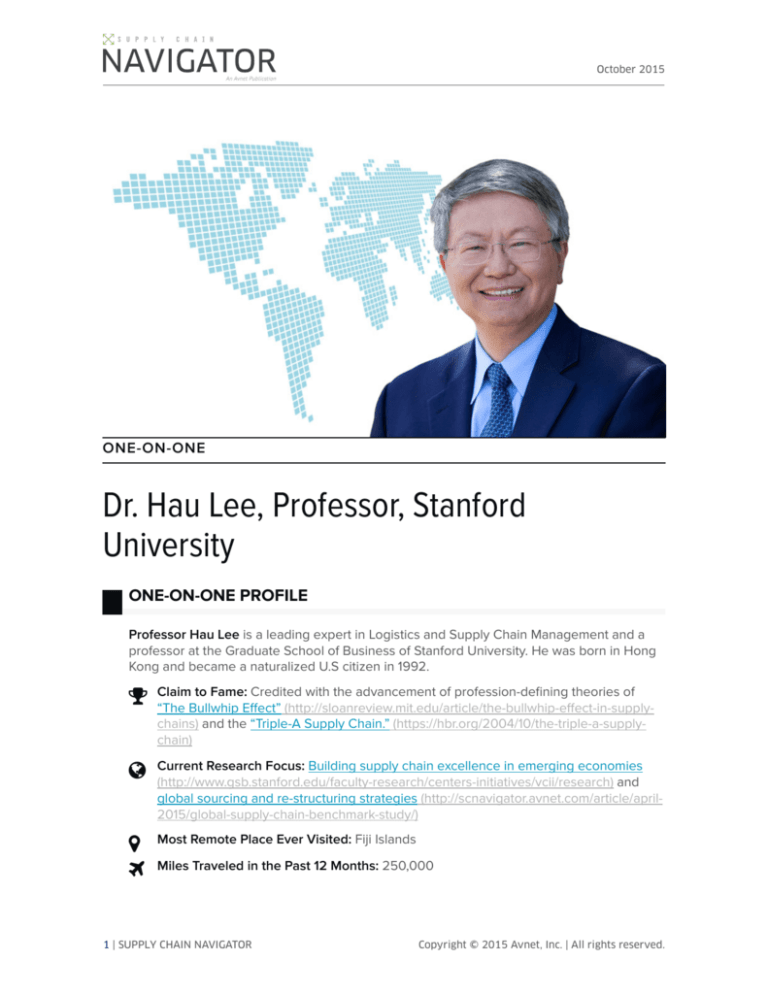
October 2015
ONE-ON-ONE
Dr. Hau Lee, Professor, Stanford
University
ONE-ON-ONE PROFILE
Professor Hau Lee is a leading expert in Logistics and Supply Chain Management and a
professor at the Graduate School of Business of Stanford University. He was born in Hong
Kong and became a naturalized U.S citizen in 1992.
Claim to Fame: Credited with the advancement of profession-defining theories of
“The Bullwhip Effect” (http://sloanreview.mit.edu/article/the-bullwhip-effect-in-supplychains) and the “Triple-A Supply Chain.” (https://hbr.org/2004/10/the-triple-a-supplychain)
Current Research Focus: Building supply chain excellence in emerging economies
(http://www.gsb.stanford.edu/faculty-research/centers-initiatives/vcii/research) and
global sourcing and re-structuring strategies (http://scnavigator.avnet.com/article/april2015/global-supply-chain-benchmark-study/)
Most Remote Place Ever Visited: Fiji Islands
Miles Traveled in the Past 12 Months: 250,000
1 | SUPPLY CHAIN NAVIGATOR
Copyright © 2015 Avnet, Inc. | All rights reserved.
October 2015
Personal Philosophy: A good teacher must always remain a student.
For a complete list of Prof. Lee’s many academic degrees, honors and achievements,
please visit his Stanford University faculty page (http://www.gsb.stanford.edu/facultyresearch/faculty/hau-l-lee).
SCN: Prof. Lee, your research and insights have shaped thinking on supply chain theory
and practice for nearly four decades. How have you been able to stay at the forefront of
both the art and science of supply chain for so long?
HL: Well, for all the years I have spent as a professor and lecturer, I have never stopped
thinking of myself as a student, first and foremost. I have been blessed to have had so
many opportunities through my career to collaborate with leaders from different
industry sectors in different regions. And in every one of these interactions, I always
look for what I can learn from the experience, because I believe that a good teacher
must always remain a student.
SCN: You are part of an industry consortium that recently completed a Global Supply
Chain Benchmark survey (http://scnavigator.avnet.com/article/april-2015/globalsupply-chain-benchmark-study/) investigating changing manufacturing sourcing
strategies. What can you tell us about the results?
HL: While we are still analyzing the results, one clear finding is that the suggestions of a
reversal of the offshoring trend, particularly as it relates to North American companies
repatriating manufacturing from low cost regions, like China, are largely unfounded.
Our research indicates that while there has been some volume decline, China remains
the most attractive region for sourcing production, while the rate of production
increase and decrease in North America is evenly balanced.
Another interesting insight relates to the service sector. Like manufacturing, services
went through a phase of heavy offshoring; and now, as customer experience becomes a
more competitive lever, we are seeing some shifting attitudes around this strategy. This
is not something that has been talked about in the mainstream, but will be an important
discussion as supply chains become more digital.
2 | SUPPLY CHAIN NAVIGATOR
Copyright © 2015 Avnet, Inc. | All rights reserved.
October 2015
As customer experience becomes a more competitive lever, we
are seeing some shifting attitudes around the offshoring of
services.
SCN: In announcing his candidacy for U.S. president
(http://www.cnn.com/2015/06/20/politics/trump-announcement-speech/), Donald
Trump stated: “I’ll bring back our jobs from China, from Mexico, from Japan, from so
many places. I’ll bring back our jobs, and I’ll bring back our money.” It’s a great
political sound bite, but is it a sound economic strategy?
HL: The problem with calls to repatriate manufacturing, like Mr. Trump is advocating,
is that they are generally driven more by emotion than a thorough total cost of
ownership analysis.
Regardless of what region companies are moving production to or from, they must
consider not just labor costs, but a variety of factors including logistics, customs and
trade, target market, etc. In addition to this geographical analysis, leading companies
are also recognizing the importance of looking at how sourcing costs and benefits vary
throughout the lifecycle of a product. As a product matures, many factors change:
volume, target market, component availability and cost, labor requirements and cost,
etc. So, a TCO calculation done using the initial production requirements will become
obsolete as the product moves farther along the lifecycle curve. As a result, these
companies may be forfeiting significant savings opportunities, which is why I
recommend companies consider taking a more staged approach to their TCO analysis.
Increasingly, leading companies are recognizing the importance
of looking at how sourcing costs and benefits vary throughout
the lifecycle of a product.
SCN: You also believe that companies risk missing out on important product and
process innovations if they are overly cautious in their offshore sourcing strategies.
3 | SUPPLY CHAIN NAVIGATOR
Copyright © 2015 Avnet, Inc. | All rights reserved.
October 2015
HL: Yes. It is important to remember that although the connectivity that pervades the
supply chain adds risk in terms of IP leakage, it also carries the potential to benefit from
advances in technology that may be driven by your suppliers. There are a number of
innovations in process and technology coming out of factories in Asia and India that
U.S. based companies have been able to leverage for their own competitive advantage.
It’s like the early days in Silicon Valley, when people were moving from one company
to the next. As a result, IP was flowing around; but in the end, this resulted in faster and
more powerful innovations that made everyone stronger.
SCN: You have been dedicated to promoting innovation and supply chain excellence in
developing economies like India and East Africa. Why is this so important to you?
HL: My interest in developing economies is two-fold. Initiatives like the Stanford
Institute for Innovation in Developing Economies (Stanford SEED)
(https://seed.stanford.edu) are committed to ending the cycle of poverty in developing
economies. The living conditions in some of these regions are more horrific than you
can imagine. So, from a personal perspective, I want to be a part of the solution.
From a more practical standpoint, the supply chain of almost every industry you can
think of now has some connection to these developing nations—both as sources of
supply/services as well as potential end markets. So it is important that we support
these emerging players, understand the unique dynamics of their economy and culture
and learn from their experience. I have been studying coffee, cotton, iron ore mines
and vineyards, for example, because I think that there are lessons that can be learned
from them that can be of tremendous value to other industries.
My experience in these developing regions has taught me that
innovation can be found in some unexpected places.
SCN: What can a high tech multinational company learn from a farmer in East Africa?
Obviously, we cannot directly borrow lessons learned about how to make seeds more
pest resistant, for example. But, there is still a great deal we can learn from farmers and
4 | SUPPLY CHAIN NAVIGATOR
Copyright © 2015 Avnet, Inc. | All rights reserved.
October 2015
miners and other “low-tech” industries. These trades have survived for centuries
because they have, in their own way, innovated and adapted to change.
What I find most interesting is the attitude toward risk. Most often, we think about risk
in terms of demand uncertainty. But in agriculture, for example, supply uncertainty is a
perennial concern. As a result, we see that, by necessity, innovations in this industry
tend to focus on how to protect and cultivate supply better. Approaches to hedging are
often more creative and contracts between buyers and sellers tend to place greater
emphasis on incentivizing sellers. Greater attention to the supply side of the equation
could be a distinct advantage to high tech companies, when, for instance, an
earthquake occurs and the supply chain for key components is disrupted.
My experience in these developing regions has taught me that innovation can be found
in some unexpected places. I urge high-tech executives to look outside the tech sector
for best practice examples of creativity and ingenuity, no matter how far afield your
core business they may seem. You never know where the spark of an idea for a
revolutionary new product or process may arise.
Hau Lee: Value Chain Innovation in Developing Econo...
Related Resources:
5 | SUPPLY CHAIN NAVIGATOR
Copyright © 2015 Avnet, Inc. | All rights reserved.
October 2015
Related Resources:
• Report: Stanford Initiative for the Study of Supply Chain Responsibility Research
(http://www.gsb.stanford.edu/faculty-research/publications/responsible-supplychain-practices-performance)
• Article: Global Supply Chain Consortium Benchmark Study, An Analysis of
Sourcing and Re-structuring Decisions
(http://scnavigator.avnet.com/article/april-2015/global-supply-chain-benchmarkstudy/)
• Article: How SEED Helped One Woman Scale an Idea and Create Thousands of
Jobs (http://www.gsb.stanford.edu/stanford-gsb-experience/news-history/howseed-helped-one-woman-scale-idea-create-thousands-jobs)
• Video: Is the Reshoring of U.S. Manufacturing a Myth?
(https://youtu.be/19_E_k8prj4)
• Webinar: Value Chain Innovations in Business Eco-Systems
(https://youtu.be/7Wuq1T0Kg-Q)
6 | SUPPLY CHAIN NAVIGATOR
Copyright © 2015 Avnet, Inc. | All rights reserved.



